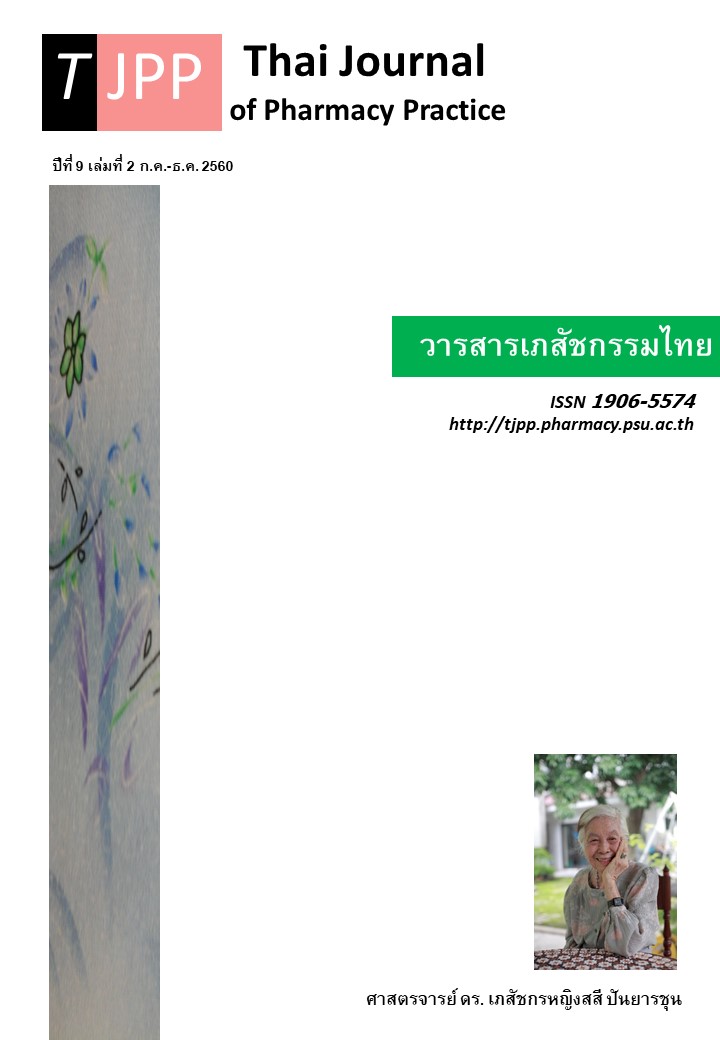ประสิทธิผลของนโยบายการส่งเสริมการใช้ยาปฏิชีวนะอย่างสมเหตุผลของสำนักงานหลักประกันสุขภาพแห่งชาติที่อาศัยการจ่ายเงินตามเกณฑ์คุณภาพของผลงานบริการ
Main Article Content
บทคัดย่อ
วัตถุประสงค์: เพื่อศึกษาผลของนโยบายการส่งเสริมการใช้ยาอย่างสมเหตุผลของสำนักงานหลักประกันสุขภาพแห่งชาติ (สปสช.) โดยอาศัยการจ่ายเงินตามเกณฑ์คุณภาพของผลงานบริการต่อพฤติกรรมการสั่งใช้ยาปฏิชีวนะ วิธีการ: การศึกษานี้เป็นวิจัยเชิงปริมาณโดยเก็บข้อมูลย้อนหลังจากฐานข้อมูลใบสั่งยาอิเล็กทรอนิกส์ของ สปสช. เฉพาะข้อมูลการบริการผู้ป่วยนอก ซึ่งส่งมาจากโรงพยาบาลใน 12 เขตบริการสุขภาพ จำนวน 912 แห่งทั่วประเทศ การศึกษาเปรียบเทียบการสั่งใช้ยาปฏิชีวนะใน 2 กลุ่มโรคเป้าหมาย คือ กลุ่มโรคอุจจาระร่วงเฉียบพลันและกลุ่มโรคติดเชื้อที่ระบบทางเดินหายใจส่วนบน ในช่วงก่อนและหลังใช้นโยบาย คือ ปีงบประมาณ 2555 และ 2557 ผลการวิจัย: การสั่งใช้ยาปฏิชีวนะในภาพรวมในกลุ่มโรคอุจจาระร่วงเฉียบพลัน ลดลงอย่างมีนัยสำคัญทางสถิติจากร้อยละ 48.57 เป็นร้อยละ 38.56 ในช่วงหลังการแทรกแซง (P<0.001) โดยเขตบริการสุขภาพที่ 8 อุดรธานี มีอัตราการใช้ยาปฏิชีวนะในกลุ่มโรคนี้ลดลงมากที่สุด คือ ลดลงจากร้อยละ 49.72 เป็น ร้อยละ 33.71 โรงพยาบาลสังกัดกระทรวงศึกษาธิการมีอัตราการใช้ยาปฏิชีวนะในกลุ่มโรคนี้ลดลงมากที่สุด คือ ลดจากร้อยละ 47.16 เป็นร้อยละ 24.15 สำหรับกลุ่มโรคติดเชื้อที่ระบบทางเดินหายใจส่วนบน การสั่งใช้ยาปฏิชีวนะในภาพรวมลดลงอย่างมีนัยสำคัญทางสถิติจากร้อยละ 53.63 เป็นร้อยละ 44.82 ในช่วงหลังการแทรกแซง (P<0.001) เขตบริการสุขภาพที่ 8 อุดรธานี มีอัตราการใช้ยาปฏิชีวนะในกลุ่มโรคนี้ลดลงมากที่สุด คือ ลดลงจากร้อยละ 56.16 เป็นร้อยละ 39.14 โรงพยาบาลสังกัดกระทรวงศึกษาธิการมีอัตราการใช้ยาปฏิชีวนะในกลุ่มโรคนี้ลดลงมากที่สุด คือ ลดจากร้อยละ 58.89 เป็นร้อยละ 47.24 สรุป: นโยบายส่งเสริมการใช้ยาปฏิชีวนะอย่างสมเหตุผลของ สปสช. โดยอาศัยกลไกการจ่ายเงินตามเกณฑ์คุณภาพของผลงานบริการ สามารถลดการสั่งใช้ยาปฏิชีวนะในผู้ป่วยโรคอุจจาระร่วงเฉียบพลันและโรคติดเชื้อที่ระบบทางเดินหายใจส่วนบน และสามารถนำไปเป็นเครื่องมือหนึ่งสร้างความตระหนักและกระตุ้นให้เกิดการปรับเปลี่ยนพฤติกรรมการใช้ยาปฏิชีวนะอย่างสมเหตุผลในกลุ่มโรคอื่นต่อไป
Article Details
ผลการวิจัยและความคิดเห็นที่ปรากฏในบทความถือเป็นความคิดเห็นและอยู่ในความรับผิดชอบของผู้นิพนธ์ มิใช่ความเห็นหรือความรับผิดชอบของกองบรรณาธิการ หรือคณะเภสัชศาสตร์ มหาวิทยาลัยสงขลานครินทร์ ทั้งนี้ไม่รวมความผิดพลาดอันเกิดจากการพิมพ์ บทความที่ได้รับการเผยแพร่โดยวารสารเภสัชกรรมไทยถือเป็นสิทธิ์ของวารสารฯ
เอกสารอ้างอิง
2. World Health Organization. The pursuit of responsible use of medicines: sharing and learning from country experiences [online]. 2012 [cited Mar 26, 2017]. Available from: apps.who.int/iris/bitstre am/10665/75828/1/WHO_EMP_MAR_2012.3_eng.pdf?ua=1.
3. O' Neill J. Antimicrobial resistance: Tackling a crisis for the health and wealth on nations [online]. 2014 [cited Mar 26, 2017]. Available from: amr-revIew. org/sites/default/files/AMR%20Review%20Paper%20-%20Tackling%20a%20crisis%20for%20the%20 health%20and%20wealth%20of%20nations_1.pdf
4. Center of Disease Control and prevention. Antibiotic resistance threats in the United States [online]. 2013 [cited Mar 29, 2017]. Available from: www. cdc.gov/drugsresistance2theast-report20132pdf2ar - threasts 2013 -508.pdf#page=6.
5. World Health Organization. The evolving threats of antimicrobial resistance: options for action [online]. 2012 [cited Mar 26, 2017]. Available from: apps.who .int/iris/handle/10665/75389.
6. Jitraknatee A. Expenditures on antibiotics. In Kiat ying-Angsulee N, Kessomboon N, editors. Report on situation of drug system in 2010: situation on antimicrobial resistant bacteria and antibiotic uses. Bangkok: Usa publishing; 2011. p 21-5.
7. Sumpradit N, Hunnangkul S, Phumart P, Prakongsai P. A survey of the antibiotic control and surveillance system and measures in promoting rational use of antibiotic. Health System Research Journal. 2012; 6:361-73.
8 Apisarnthanarak A, Danchaivijitr S, Khawcha roenporn T. Effectiveness of education and antibio- tic-control program in tertiary hospital in Thailand. Clin Infect Dis 2006; 42:768-75.
9. Phumart P, Phodha T, Thamlikitkul V, Riewpaiboon A, Prakongsai P, Limwattananon S. Health and economic impacts of antimicrobial resistant infections in Thailand: a preliminary study. 2012; 6: 352-60.
10. National Committee on Drug System Development. National drug policy B.E. 2554 and strategies for drug system development B.E. 2555-2559. Nontaburi: Publising House of Agricultural Coopera- tive Federation of Thailand; 2011.


